School closure on Alaska Air Force base highlights effects of education policy choices
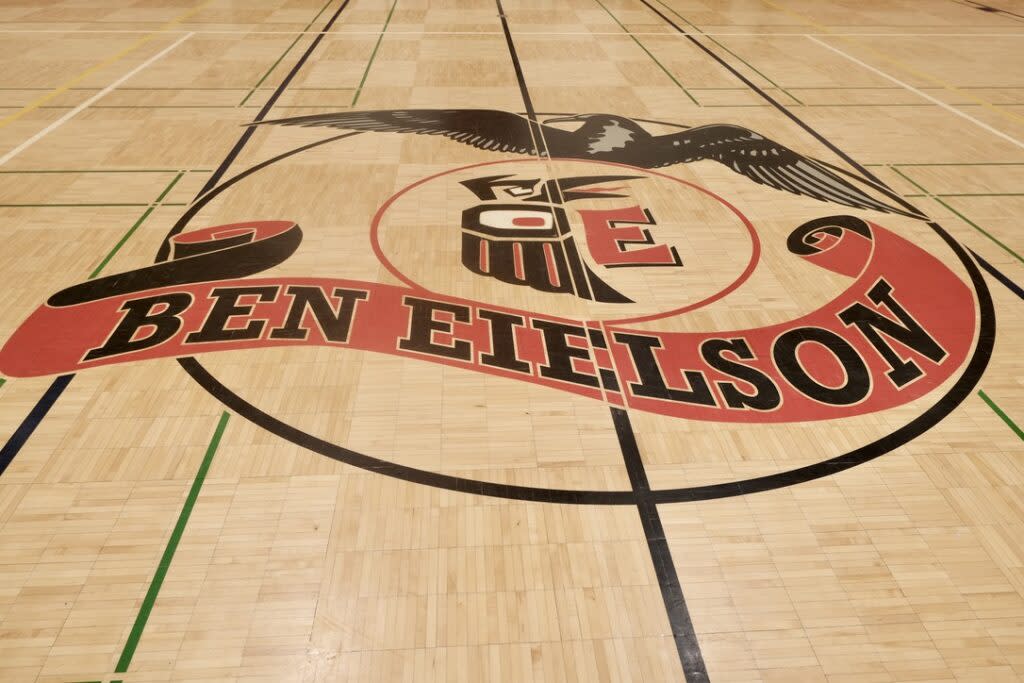
- Oops!Something went wrong.Please try again later.
The Ben Eielson Junior Senior High School basketball court sports the school's mascot on April 22, 2024. The school will close at the end of the year due to budget constraints. (Photo by Claire Stremple/Alaska Beacon)
Zoe Fuller said she has made some peace with the news of her school’s closure, but initially, she said she was really upset. She and her friend Kaitlyn Manning chatted easily on Monday as they walked down Ben Eielson Junior Senior High School’s linoleum halls, lined with sports trophies and blue lockers. Ben Eielson is a state-run school on a military base, so most lockers have purple stars taped on them to show the student is from a military family.
The juniors are both leaders in student government; they play sports and are leaders in the Junior Reserve Officer Training Corps program. Manning said she’d planned out her path carefully, but her achievements don’t feel like they matter anymore: “We’ve been working for the positions that we have and now they just don’t mean anything,” she said.
Besides the social and academic stresses of changing schools for her senior year, Fuller said there’s a deeper feeling of loss. “I’m a third-generation student at Ben Eielson,” she said. Her grandparents met here. Her mother and aunts and uncles graduated from here. But next year she will graduate instead from North Pole High School, 10 miles down the road. “I don’t know,” she said with a shrug as she pulled her feet up onto her chair so her whole body was scrunched in a ball, “It’s kind of hard to see all that — disappear.”
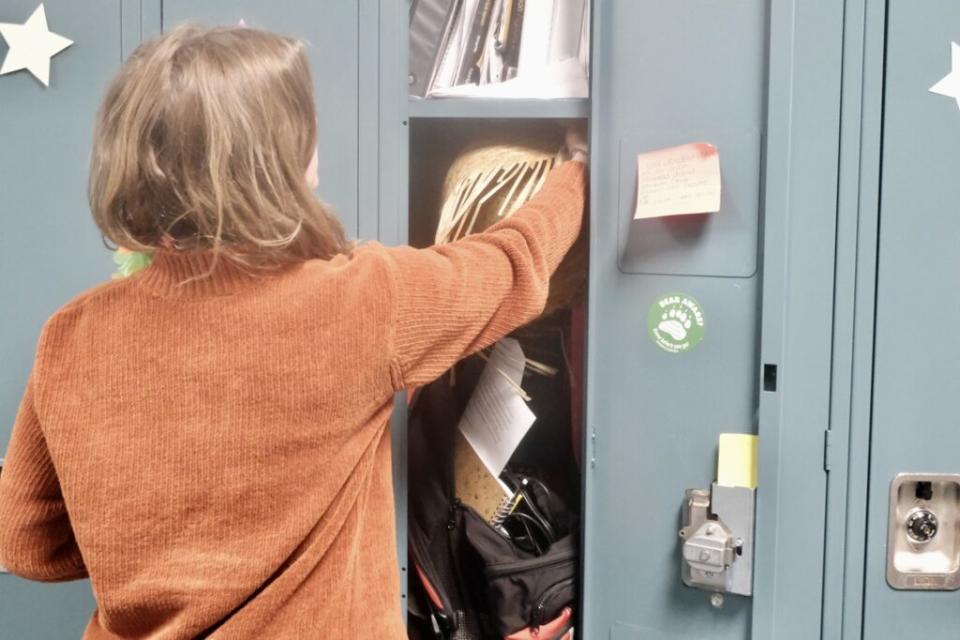
High school Junior Kaitlyn Manning reaches into her locker at Ben Eielson Junior Senior High School on April 22, 2024. (Photo by Claire Stremple/Alaska Beacon)
“It’s hard to see the community here go,” her friend Kaitlyn added. “Because I feel like looking at other schools, they aren’t as close together as we are.”
The closure of Ben Eielson Junior Senior High School is the dispersal of a close-knit learning community — and a result of education policy on both the state and the local levels that has left the Fairbanks North Star Borough School District with a multimillion dollar deficit. The building will be the second former school to sit empty on Eielson Air Force base and the fourth school the district has closed since 2022.
Brandy Harty, the local school board president, said the decision weighed heavily on every member of the board. Ben Eielson was one of four schools the district recommended closing for immediate cost savings.
“Nobody wanted to close any of the schools. And the hardest part is, we’re not telling our community that more aren’t going to close,” she said. Over the summer, the board will have to fix a funding gap that, depending on the results of a local special election and whether lawmakers in Juneau add funding to schools, could be up to $10 million this year.
Harty said the school board would have had more time to consider how to downsize the district — and would not have had to immediately close Ben Eielson — if Senate Bill 140, an education bill containing a $680 increase to the per pupil formula that funds Alaska schools, had not been vetoed by Gov. Mike Dunleavy earlier this year.
Other districts are shrinking, too. Juneau’s school district will close two schools and its administration building next year to make up for a more than $9 million budget shortfall and Anchorage School District has announced plans to consolidate its schools as well, citing declining enrollment. The district has a projected $98 million fund gap next year.
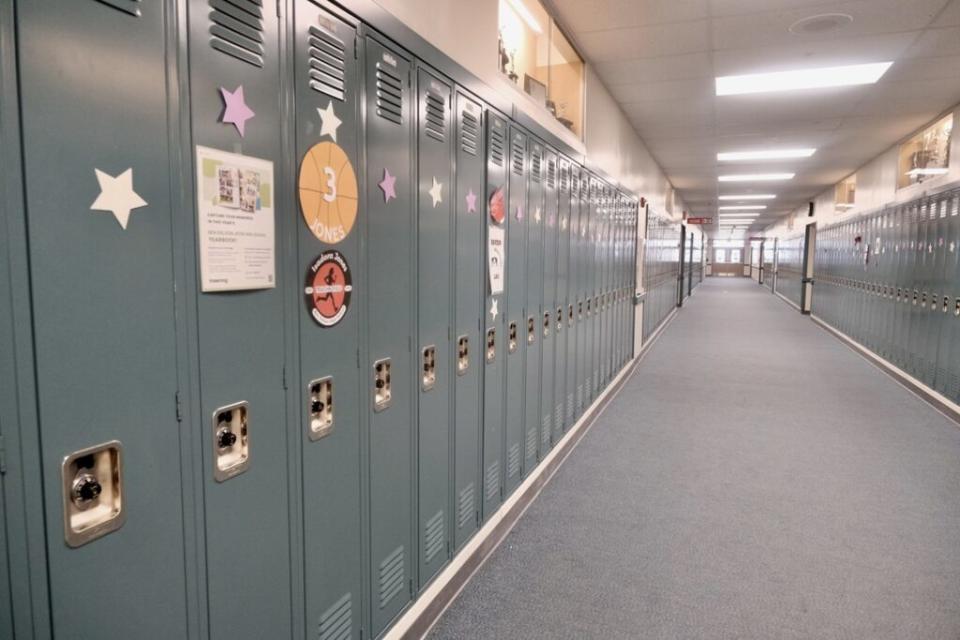
Lockers line the halls of Ben Eielson Junior Senior High School on April 22, 2024. (Photo by Claire Stremple/Alaska Beacon)
The state Legislature has less than three weeks left to make any changes to education policy before the end of its session this year. The only proposal currently under debate for a permanent education funding increase is House Bill 392, which also contains the $680 per pupil boost to the state’s funding formula. In addition, it contains a number of Dunleavy priorities that have been at the center of education policy controversy, including a change to the state’s charter school approval process that the Senate’s majority caucus has called a “nonstarter.”
If lawmakers do not pass the bill, the best educators can hope for is a one-time funding increase. Generally one-time funds are not used to raise teachers’ salaries, the largest component of most district budgets, because teacher contracts are negotiated on a three-year basis. Charter schools can also get short shrift with one-time funding because districts do not have to distribute one-time funds the same way they do money under the state’s per pupil funding formula.
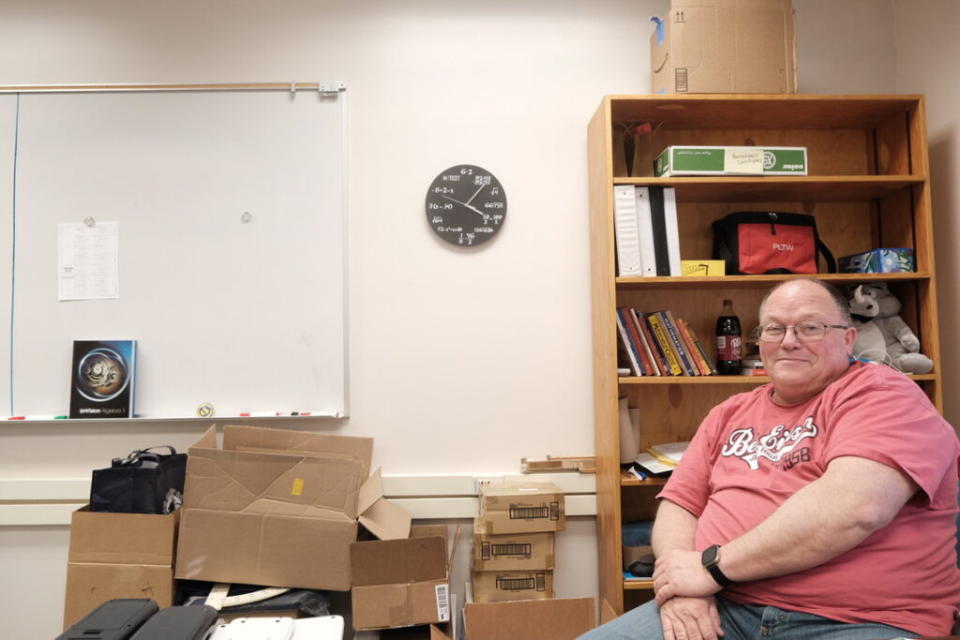
Math teacher Steve Mosley sits in his classroom at Ben Eielson Junior Senior High School on April 22, 2024. He has mostly packed his materials in anticipation of moving to North Pole High School next year. “Very sad to see the school close. It had a really important impact in the community and especially on base kids. They come in and out of here every three years for the most part, so it was a good place for them to gather with their peers the smaller school environment,” he said. (Photo by Claire Stremple/Alaska Beacon)
Stagnant state funding has increased pressure on the Fairbanks North Star Borough to fund its schools at a time when it is uniquely unable to do so, according to Harty. Usually, the borough would be able to contribute significantly to increase funding for its school district. But she said this year a newly lowered tax revenue cap means the borough cannot collect enough money to do that. The previous assembly in 2023 adopted the borough’s lowest tax rate in nearly 40 years. That decreases the tax money the borough can collect this year by nearly $20 million. “We could not, without eliminating other borough services, fund education to the cap anymore,” Harty said.
The Fairbanks Assembly aims to increase the amount of taxes the borough can collect so that it can better fund schools. In a special election next month, voters will decide whether to increase the tax revenue cap by roughly 10% so the borough could increase education funding by $10 million.
Harty said Fairbanks property owners would not have to choose between a lower tax rate and the school district if the state had been sufficiently funding education. And she said it’s a tough choice because property taxes are already high. “Would Fairbanks need to raise the tax cap if the state were appropriately funding schools?” she asked, then answered her own question: “No.”
Strain on military families, mission
At the base’s Field House, Joanna Livaudais wrapped athletic tape around a pull up bar. She runs the CrossFit fitness classes there and her husband is in the Air Force. They have three school-aged sons. “This is really hard on all of my kids, all of my kids have been greatly affected by the closure,” she said. Her two older sons go to Ben Eielson and pick up her youngest from the elementary school across the street in the afternoon.

Joanna Livaudais tapes the pull-up bar at the Ben Eielson Air Force Base in preparation for a CrossFit class she teaches. Her three sons will be affected by the closure of the base’s junior and senior high school at the end of the year. (Photo by Claire Stremple/Alaska Beacon)
Immediately after the board voted to close the school, she said her family was less likely to stay in Alaska, where she grew up and planned to retire. “I didn’t think it was going to be this emotional,” she said as her voice broke. “While we love Alaska and it’s home to me, the failing education system is keeping us from planting deeper roots here, as of right now.” She said several friends extended their enlistments so their kids could stay at the same high school. Now they have to change schools anyway. She said it felt like military families had to bear the brunt of the district’s financial shortfall because they are less likely to stay in the state and less likely to vote in local elections.
Livaudais said she doesn’t know if a school funding boost would have saved the school, but she thinks districts need more funding — and likely some reform. “If you want people to stay up here, and you want people to come to the state, you’ve got to be able to provide a good education,” she said.
Both of Eielson Air Force Base Commander Col. Paul Townsend’s children attend Ben Eielson Junior and Senior High School. He said the Air Force has invested in growing the Eielson base, and the school is a key part of supporting military families stationed there. “Academic stability and quality, I think that definitely has an impact on members,” he said.
Townsend and the school board’s base representative Col. Antonio Alvarado said the school closure could have an impact on readiness because families will have to spend more time commuting to get their kids to school and activities in North Pole. “We’re about a 40-minute round trip or so, give or take, in good weather,” Townsend said of the drive for his family. He added that many military families come from other states, and don’t have the backup of grandparents to help with child care and transportation for their kids.
Townsend met with district leaders to communicate the importance of the school and held community meetings to talk about the change, but was unable to stave off the closure.

Sgt. Manning stands by boxes full of JROTC gear slated to be donated at the end of the year on April 22, 2024. The whiteboard behind her lists her students’ academic and military achievements. (Photo by Claire Stremple/Alaska Beacon)
More than half of the students at the Ben Eielson school come from active duty military families. Back on campus, that was especially evident in the JROTC classroom. It was piled high with moving boxes full of equipment. “Uniforms, robotics kits, curriculum, winter survival gear,” said Sgt. Kathryn Manning with a gesture towards the boxes as blue-uniformed cadets folded flags on a cluster of desks. Most of the gear will go with students to North Pole schools; the rest will be donated. She has run the program at Ben Eieson for five years.
Manning wrote each scholarship and college acceptance on a white board in red marker. “We capture that to show what each student has done with their time in this program,” she said. Several students will start careers in the military and several others have already earned their pilot’s licenses through the program.
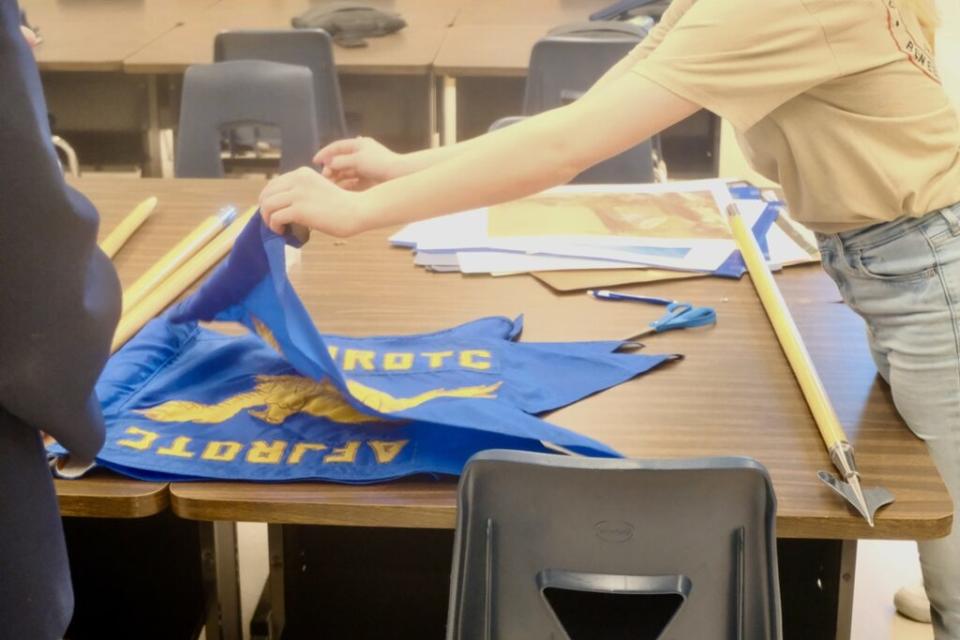
An Air Force JROTC student folds a flag in a Ben Eielson Junior Senior High School classroom on April 22, 2024. (Photo by Claire Stremple/Alaska Beacon)
Sgt. Jeremy Burkeen helps run JROTC and is set to lead it at North Pole High School next year. He and his wife chose to stay on the base in Fairbanks so their two daughters could have stability through their high school years.
“Definitely a detour in the plan,” he said of the closure. His daughters will go to the North Pole school next year, too. “This ecosystem that is Ben Eielson is a very unique place, even throughout the Air Force, so it’s very sad to see it disband.”
The last year
Principal Bruce Bell’s office is full of red and black Ben Eielson paraphernalia, and after nearly a decade at the school, he said its colors permeate his wardrobe, too. He has students and staff at the front of his mind as he guides the school through its final year.
“We pride ourselves on being small and nice and kind of a small-knit community, that we know our kiddos and know our families,” he said. “And so we’re definitely feeling the emotions of closure, that this isn’t gonna exist.”
But he acknowledged that the cost of operating the small school is high, and that it’s been harder to offer the same amount of courses as some other schools. When two teachers retired last year, the school lost four Advanced Placement courses. The district will save more than $2 million by closing Ben Eielson. For the district it was a trade-off that means class sizes everywhere else don’t have to go up.
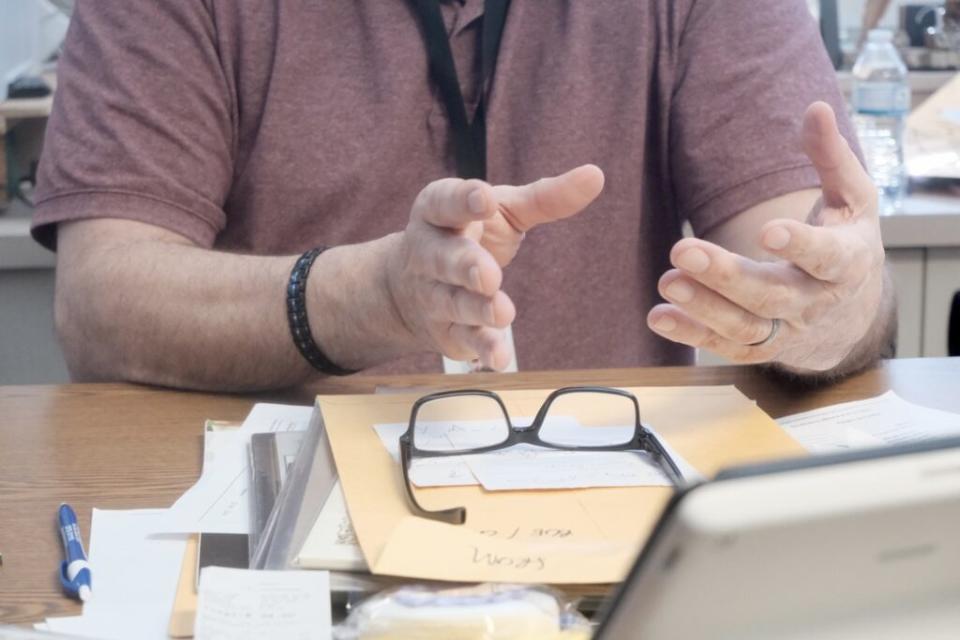
Ben Eielson Junior Senior High School principal Bruce Bell explains the mechanics of closing a school on April 22, 2024. (Photo by Claire Stremple/Alaska Beacon)
Most of Bell’s students will go to North Pole Middle and High Schools next year, so he has arranged several school visits to increase familiarity with the new campuses. He has also invited the counselors from those schools to meet students at the Ben Eielson campus. Staff has to pack up the classrooms and the decorations, pictures and trophies that bring the halls to life, but Bell said they aren’t touching the main corridor until after graduation in May. “We don’t want it to look like we’re moving out while they’re graduating,” he said.
Staff is planning a special celebration the day after graduation for students to say goodbye to the school. Bell said he doesn’t quite know what to call it; “community closure” was one failed moniker. “The best I’ve come up with is community celebration,” he said.
Bell grappled with words to describe his personal reaction. “Heartbroken — is just my feeling, but it’s my job to be there for the staff,” he said.
There are some challenges even careful planning cannot offset. The school opens its doors early so military parents can drop their children off before they report for duty at 7 a.m. “If the drop-off time at North Pole High is 7:00, they’ll be late to work,” he said.
Wendy Clark, the school’s counseling technician, snatched a tissue off his desk when she described the effects of the closure. “For me, it’s a rough one, because this is a family,” she said. “I honestly did not think that this was going to happen.”
Her desk sits below a poster that says “Don’t let your ice cream melt while counting someone else’s sprinkles.” She quickly checked in on a student who was sent to the office for discipline and gave him a task. Behavioral issues have increased a bit because some students are struggling with the change, she said, but for others it’s exciting. “My juniors are hit the hardest,” she said.
“Wendy knows every student in this school,” one of her colleagues said as she passed the door to Clark’s office. “You won’t get that at another school.”
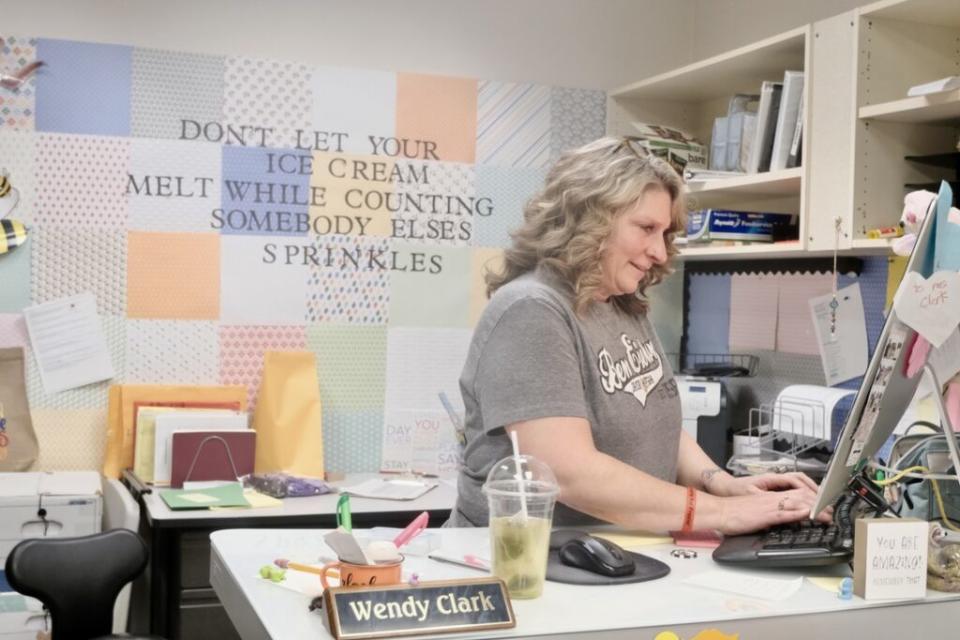
Wendy Clark keeps an eye on students coming in to the front desk as she manages work on her computer on April 22, 2024. She said she is “salty” about the closure of Ben Eielson at the end of the school year. (Photo by Claire Stremple/Alaska Beacon)
Back in the hall, Zoe Fuller’s locker is full of books, cleats and JROTC gear. She tossed out an empty snack wrapper and picked up some note cards decorated with the school’s raven and lynx mascots.
“They were throwing everything away,” she said.
She kept them to write goodbye notes to her friends from the graduating senior class.
“I think also it kind of feels like almost our own graduation. Because like, we’ll be going to high school next year, but it’s not — we’ll be graduating from this school, if that makes sense,” she said.
Manning jumped in to finish her friend’s thought. “Going to North Pole is cool,” she said.
“But it’s not our school.”
Correction: Eielson was misspelled twice in the original version of this article.
GET THE MORNING HEADLINES DELIVERED TO YOUR INBOX
The post School closure on Alaska Air Force base highlights effects of education policy choices appeared first on Alaska Beacon.

